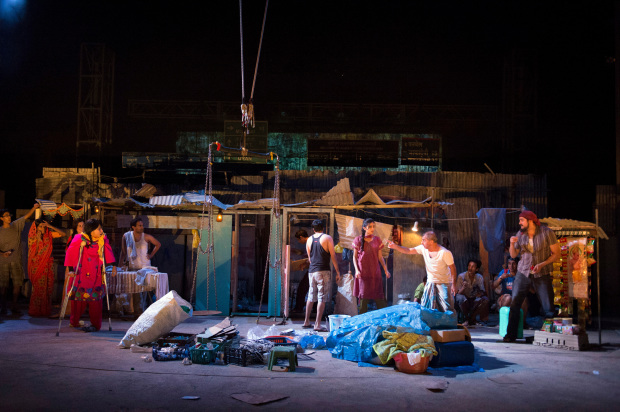You have no items in your cart. Want to get some nice things?
Go shopping
The public attitude to the poor has been much on my mind lately. “The poor” – a dehumanizing term in itself – provides umbrella coverage for a range of different states of scarcity. There is the immediate and local poverty of those without homes this winter, too often ignored in our eyes-down journeys to work. And then there are the distant poor: those who inhabit the faraway “world of dread and fear”, or so the accusatory croons of Bob Geldof’s ensemble of pop stars tell us. Next month sees the release of Annie in cinemas, a musical about an impoverished but spirited orphan, while the National Theatre will play host to David Hare’s Behind the Beautiful Forevers – set in a Mumbai slum – until April. Hare’s play, adapted from Katherine Boo’s non-fiction narrative of the same name, places sentimentality firmly aside, bringing an unflinching microscope to the lives and untimely deaths of the Annawadi slum-dwellers. The despair and ambitions of these characters are rooted in reality and, as a result, feel more authentic than the cartoonish sighs and Hard Knock Lives of Annie and her pals. And Behind the Beautiful Forevers has already been heralded as a success by critics; but what is it that appeals here which seems to have disgusted coming from the well-meaning mouths of One Direction and company? Is there a correct way of representing poverty, and, if so, why is this the case?
The ultra-emotive portrayal of the impoverished in Band Aid’s single has its roots, I would suggest, in the writing of Charles Dickens. Dickens’ father, a debtor, was forced into the notorious Marshalsea prison when Charles was still a young boy. His experiences of visiting his family there and of supporting himself with a job in a warehouse became fodder for later novels: Little Dorrit and Oliver Twist among them. The paupers of Dickens’ imagining are often children, and this crowd of long-suffering innocents petition for our sympathy throughout his work. Their plight is wrought with sentimentalism – and understandably so, perhaps. Dickens is reacting to the childhood he himself suffered, along with the implementation of the New Poor Law in 1834.
Oscar Wilde, who lampooned Dickens for the mawkishness of his portrayals of the poor, is himself guilty of violent heartstring-tugging. His fairy-tale The Happy Prince describes a gilded statue giving away his wealth to the needy in the city he surveys. But, alas, their lack becomes too much, and at length ‘a curious crack sounded inside the statue, as if something had broken. The fact is that the leaden heart had snapped right in two.’ Despite his protestations, Wilde is not completely impervious to sentimentality, it seems.
Elsewhere, Victor Hugo’s beautiful factory worker Fantine is made martyr-like in her selflessness. She prostitutes herself to protect her daughter, before dying of tuberculosis and orphaning the young Cosette. It is an unhappy fate for the girl, albeit a predictable one; the trope of the orphaned pauper has been made rather hackneyed in its many retellings. It has been employed before in the figure of Jane Eyre, and, of course, endlessly by Dickens. It is revived again by Francis Hodgson Burnett in her syrupy children’s book, A Little Princess.
The descendants of these honest, impoverished children are those cheerful underdogs invented by the movies, the ragtag groups of working class characters who inhabit the silver screen. Charlie Chaplin’s beloved turn as “The Tramp”, a goofy, good-hearted vagrant who makes his way itinerantly through many a mishap, established this theme, which other rags-to-riches films – Cinderella, Aladdin, My Fair Lady, Pretty Women and Annie, to name a few – see through to the present day.
This longstanding habit of patronization seems not to have been a problem, thus far. And yet, the reaction against this year’s Band Aid single is too great to dismiss. So what has changed? Well, perhaps we have decided that the time has come for “the poor” to have a voice of their own. This is something they have long been denied – class prejudice and lack of education have too often stood in the way.
Earlier this year I picked up Katherine Boo’s Behind the Beautiful Forevers, the book based on her three years of experience in a slum near Mumbai airport. Needless to say, I found no sentimentality here. Corruption reigns in this Indian underbelly. Our protagonist, Abdul, the only honest worker in Annawadi, it seems, is hardened; he notices that the “Indian criminal justice system was a market like garbage… Innocence and guilt could be bought and sold like a kilo of polyurethane bags.” In this shanty-town, even acts of goodness have an agenda. For the gifted Manju, the “desire to be good was also rebellion – a way of chastising a mother who was said to have acquired the television set and other advantages by behaving badly”. These characters have ditched the sentimentality frequently afforded to others in their situation and have taken up, instead, the fierce mantle of free will.
This story, epic in scope, translates well to the stage. David Hare borrows neatly from Boo’s observations (although losing much of her lyricism in the process, sadly), while Rufus Norris directs an able and fleet-footed cast. I could urge you to see this production for its breath-taking set – a lifting, spinning marvel of a design, which conveys so clearly the vitality of Mumbai. In the middle of Katrina Lindsay’s stage hang a pair of giant scales to weigh the rubbish – an apt metaphor for the troubled ethics of the Annawadians. Alternatively, I might suggest that you see it for the acting, which is stellar, led by the brilliant Meera Syal. But what I really think you should watch it for is the portrayal of the living, breathing, unlovely and likeable characters who have shed the romanticism that their fictional counterparts have struggled with for so long. As Boo herself professed in an interview with her American editor Kate Medina: “My hope, at the keyboard, is to portray these individuals in their complexity – allow them not to be Representative Poor Persons – so that readers might find some other point of emotional purchase, a connection more blooded than pity.”
In this she has succeeded. And while there is not very much wrong with well-intentioned Christmas singles, it is nice to find a hint of realism in our depictions of “the poor” for a change, to see attention paid to personality and motivation, and the tradition of the naïve under-classes put to rest momentarily. For me at least, the realistic “stink of trash and… fear-sweat” of Boo’s book, and Hare’s adaptation, comes as a welcome breath of not-so-fresh air.
Behind The Beautiful Forevers continues at the National Theatre until April 13 2015.

About Xenobe Purvis
Xenobe is a writer and a literary research assistant. Her work has appeared in the Telegraph, City AM, Asian Art Newspaper and So it Goes Magazine, and her first novel is represented by Peters Fraser & Dunlop. She and her sister curate an art and culture website with a Japanese focus: nomikomu.com.




